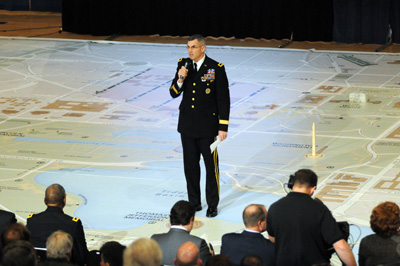By C. Todd Lopez
WASHINGTON (Dec. 13, 2012) -- As the nation prepares for another presidential inauguration, Jan. 21, military services in the National Capital Region are gearing up to provide support to the event, as they have done every year since George Washington took office.
"Military support to the inauguration is appropriate, traditional and important in my mind in honoring our president and commander-in-chief," said Maj. Gen. Michael S. Linnington, commander, Joint Task Force-National Capital Region. "It also recognizes our commitment to civilian control of the military."

At the District of Columbia Armory, a 10,000-seat arena, a 40-by-60-foot map that includes the entire downtown area of the nation's capitol and also parts of Virginia was laid out on a floor where Marilyn Manson once played and which currently serves as the home for the D.C. Rollergirls, a female roller derby league.
Both military and civilian planners who will be involved in executing support for inauguration events in Washington, D.C., met at the Armory to conduct a "MAPEX," or map exercise, to coordinate and solidify support actions for the inaugural parade.
"The rehearsal allows different participating units to physically walk on the map as they are speaking though what they are doing," said Linnington. "As they are walking through the routes, folks along the routes or who have other events taking place can see the effect of what is going on with what their event is. It's a very good tool for synchronizing events in time and space."
The map exercise is just one of nearly two-dozen types of exercises and walk-throughs that will help solidify military support during the 10-day period of inauguration events, Jan 16-25.
Military support to the inauguration includes marching bands, musical units, color guards and honor cordons. Service members will also march in the inaugural parade and provide security in certain areas. Some National Guard service members will even be deputized by the Washington, D.C., Police to help with crowd control.
When it's all over, more than 12,000 service members will be able to say they participated in the inauguration in some way.
While crowds during the 2013 inaugural event are expected to be significantly smaller than they were in 2009, planners for the event are still preparing the same way they did for President Barack Obama's first inauguration, said Maj. Gen. Errol R. Schwartz, commander, National Guard, District of Columbia, Joint Forces Headquarters.
"We are still looking at what are the possibilities that may occur in the smaller crowd," he said.
On the lookout will be some 6,000 National Guard Soldiers and Airmen, who will be on the streets keeping things safe for those who hope to witness the inauguration and attend the parade. Many of those Guardsmen will be pulled from the Army's military police, or the Air Force's security forces. "They have a good eye for those kinds of crowd-management issues," Schwartz said.
One concern for both Linnington and Schwartz is cold weather, which makes things difficult for both those providing logistics to the event and those attending the event.
"As you look at safety and force protection of your ceremonial units, if it's bitter cold and snowy, it makes life more complicated," said Linnington. "So weather would be first and foremost on my mind."
Schwartz said there is also concern for civilians who are attending the event.
"The individuals who are coming to the ceremony will have to understand that it is going to be cold, they will be standing for a long time, they will be walking a long ways," Schwartz said. "We are concerned about individuals making sure their health considerations are taken care of."